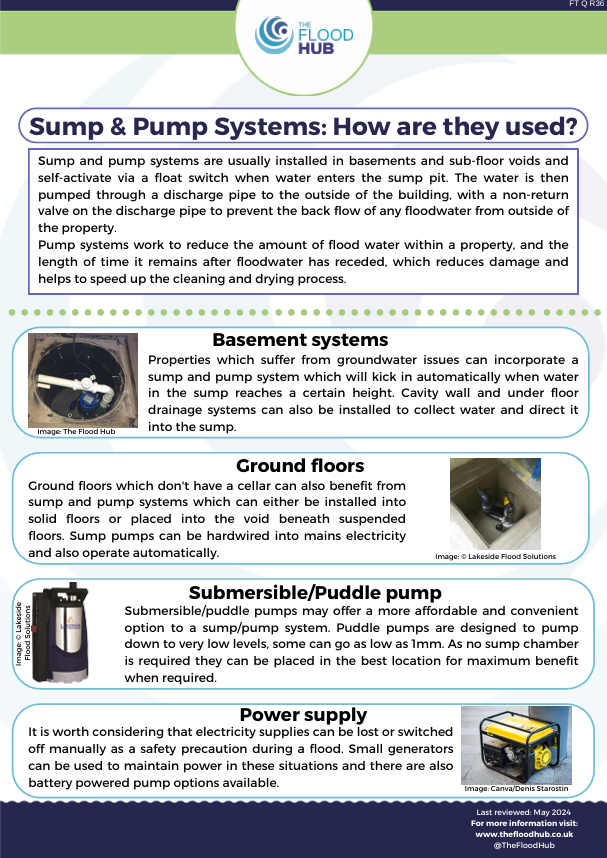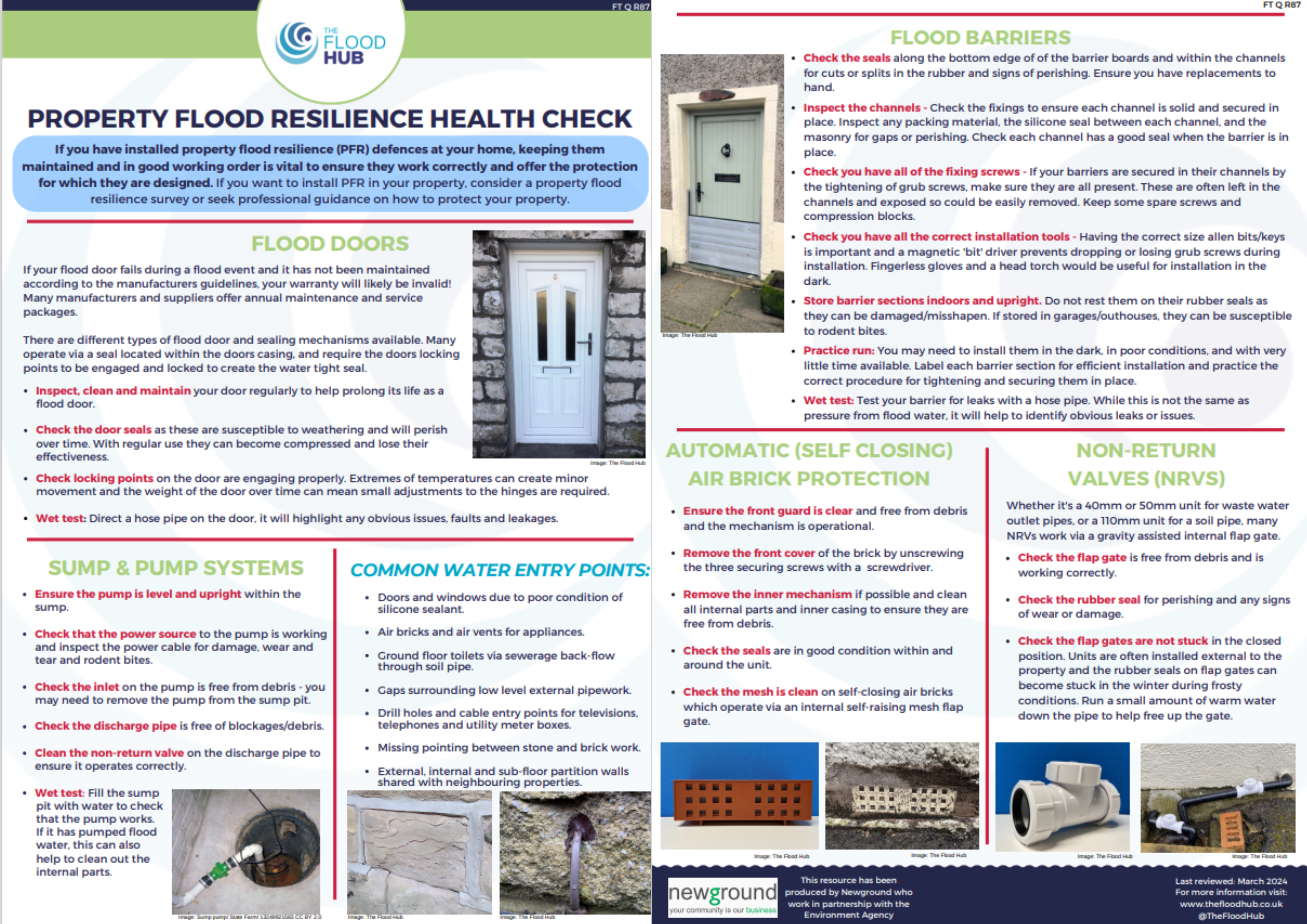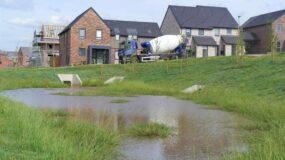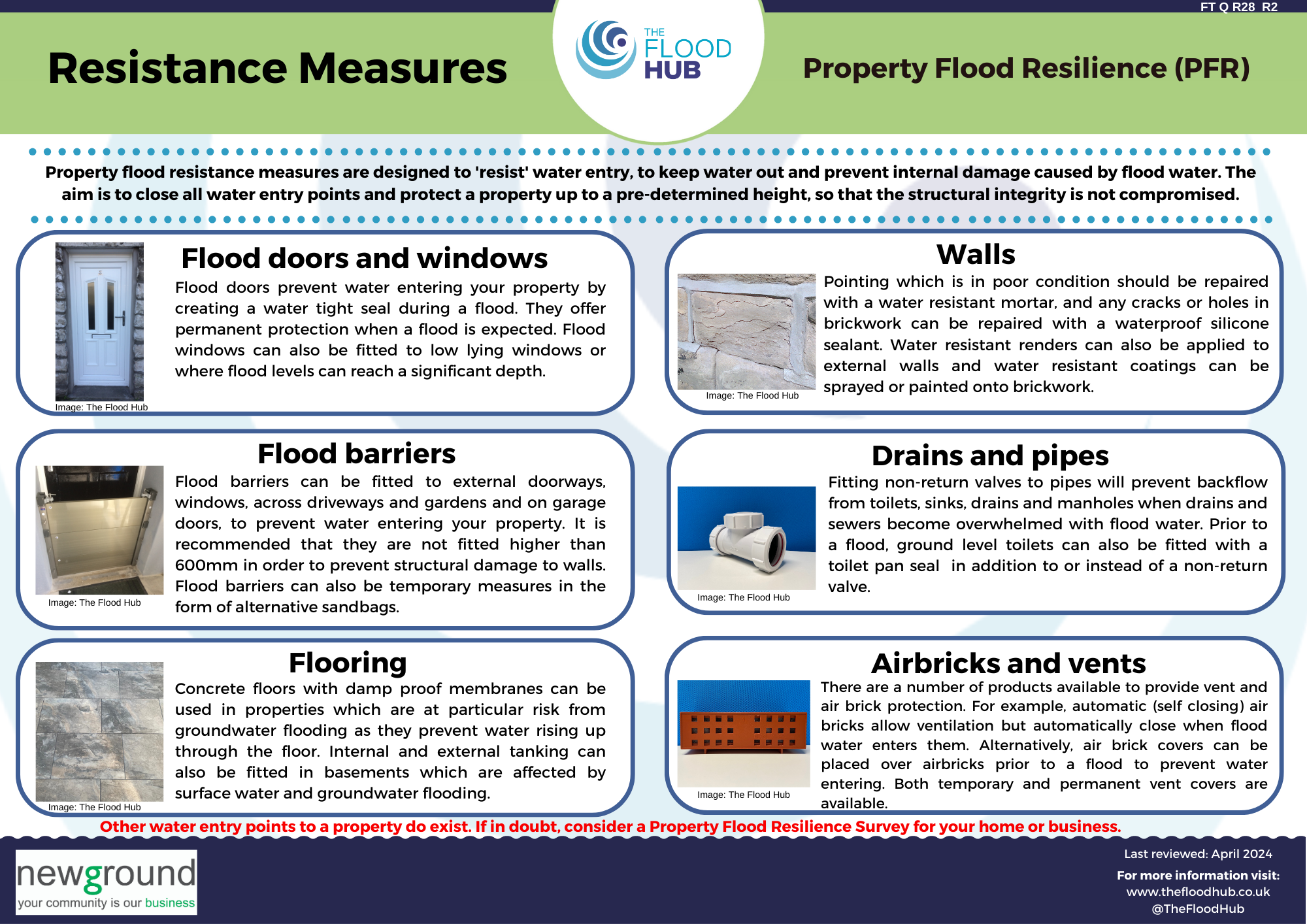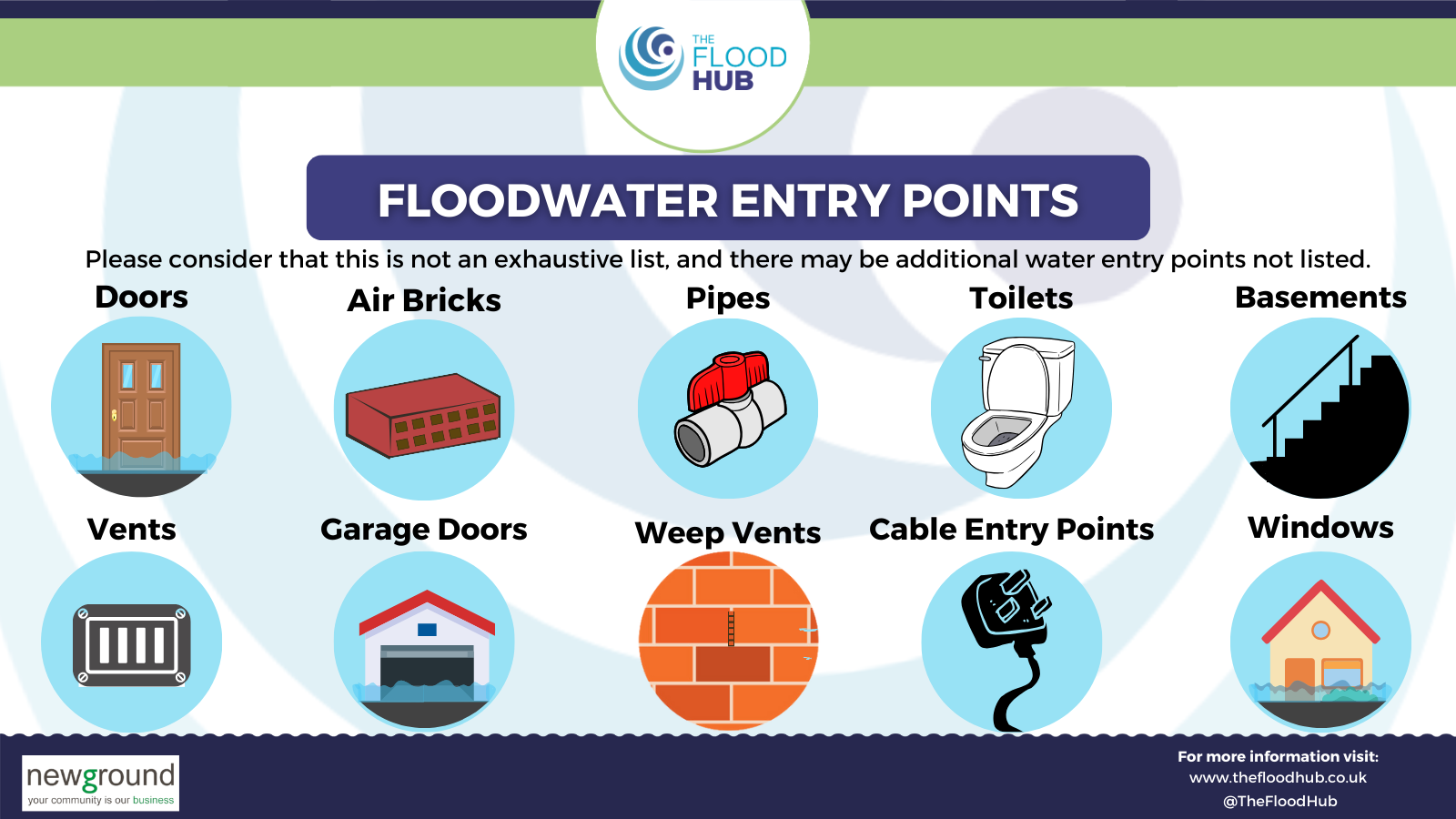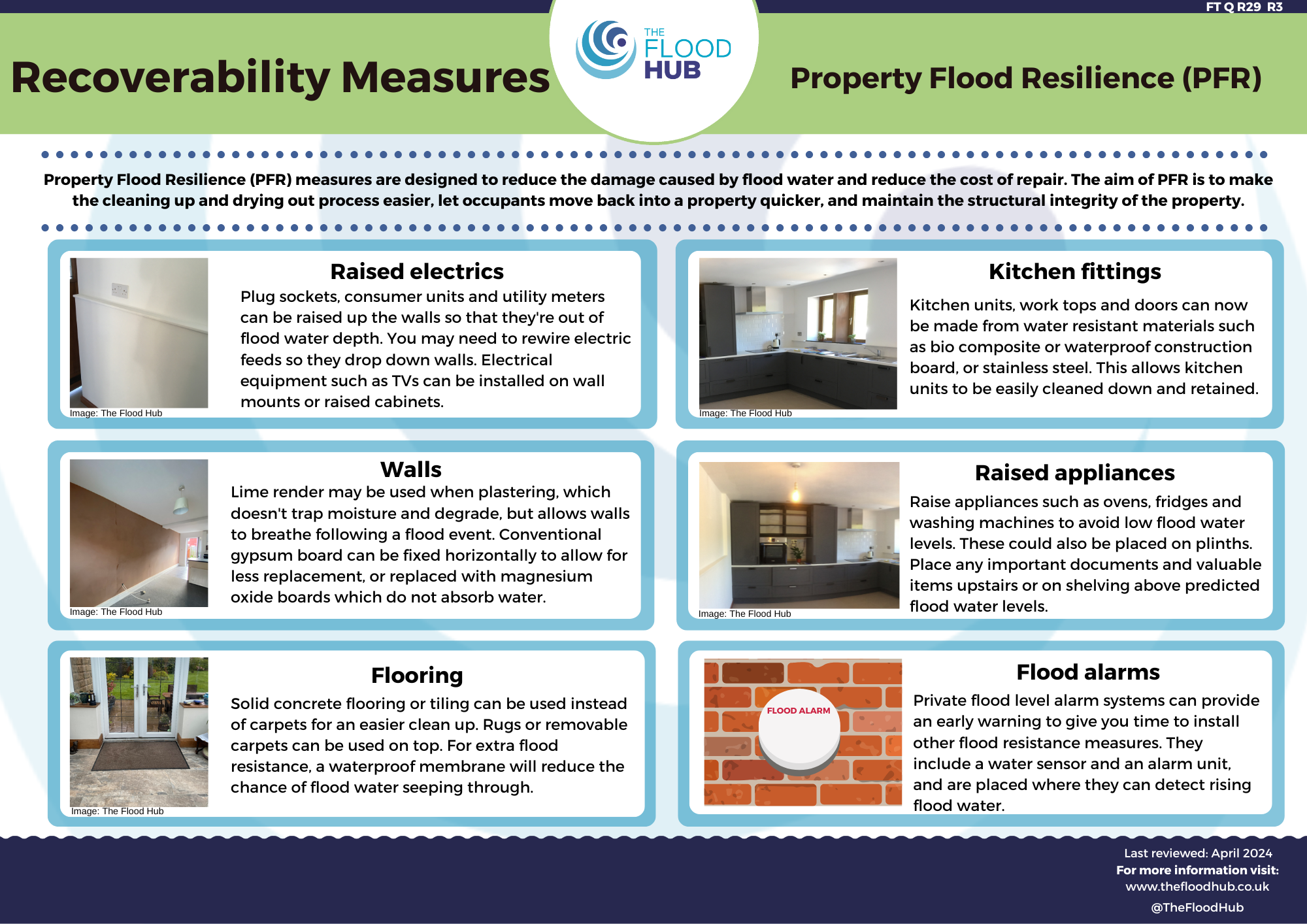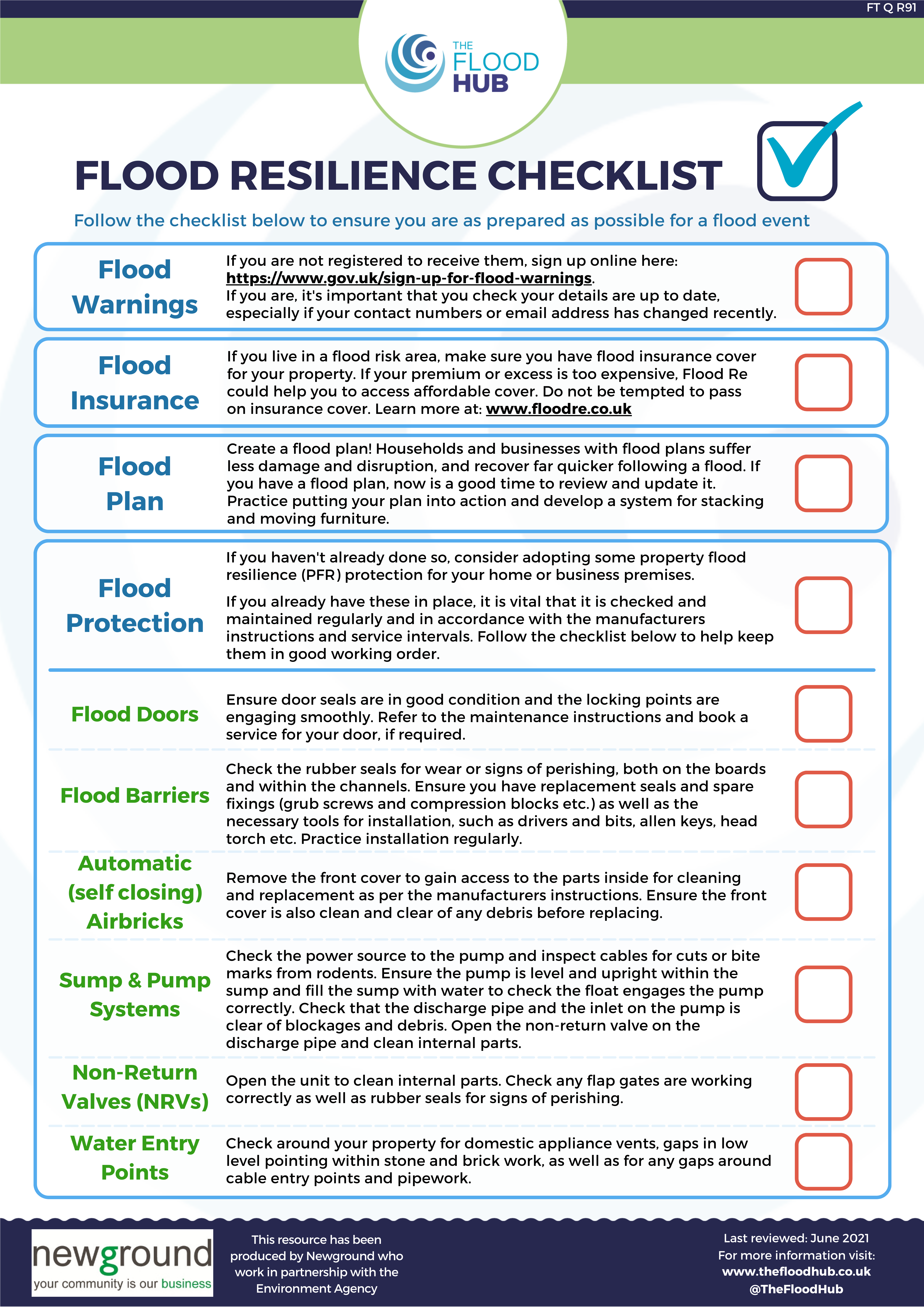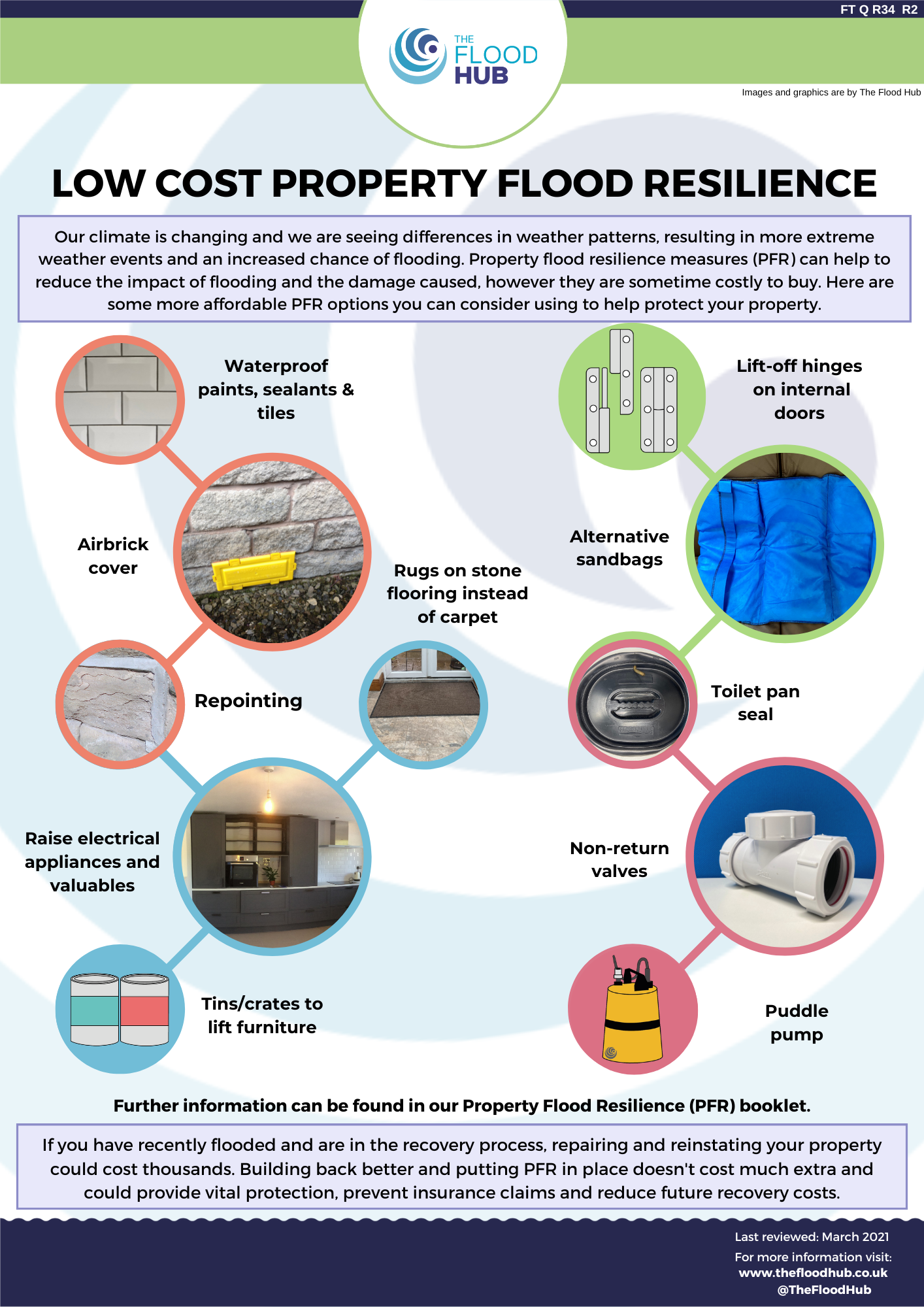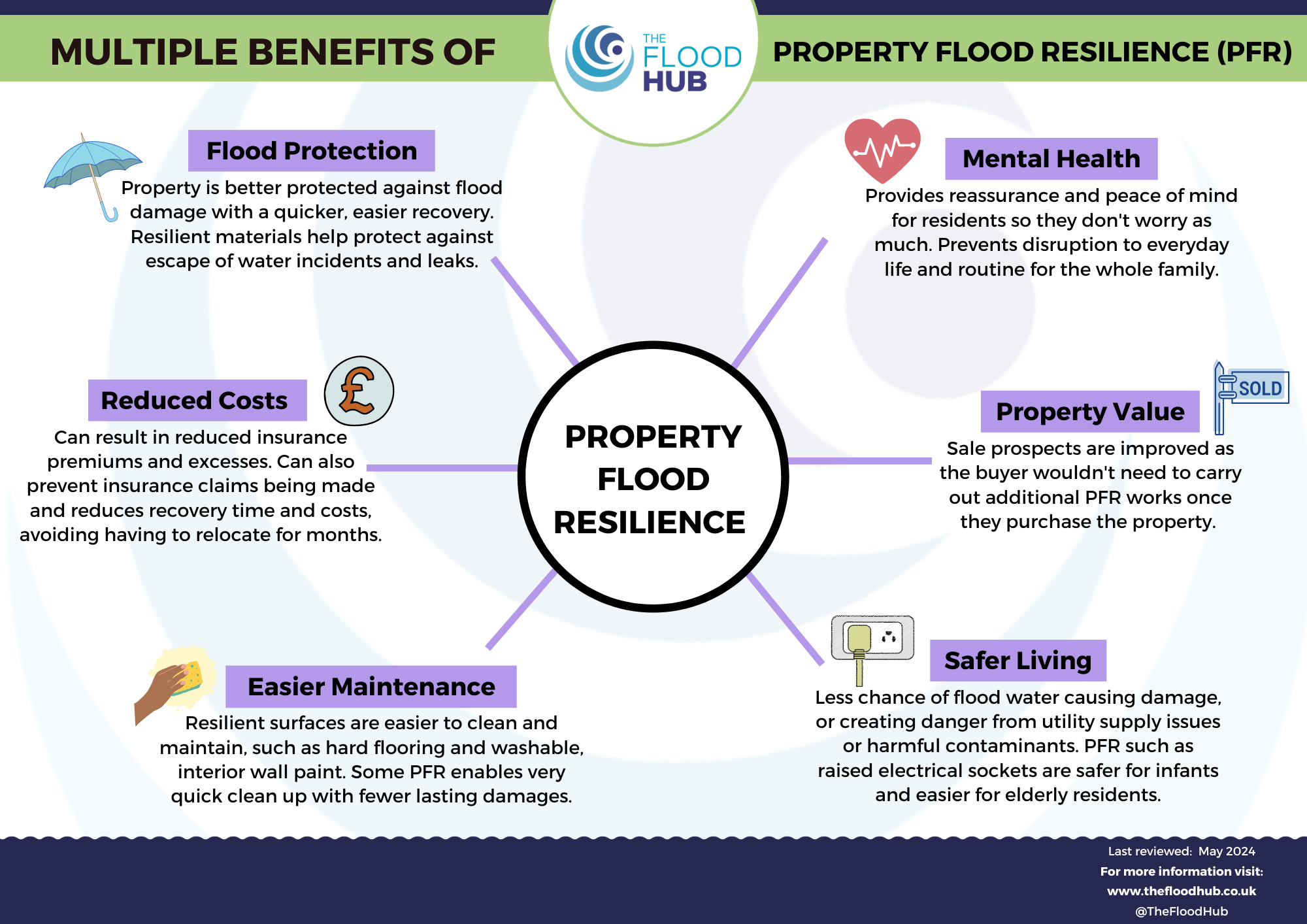The products outlined on this page provide an idea of the types of products and methods available to help make your property more resilient to flooding. The list isn’t exhaustive and there are other products available that are not listed here. The Flood Hub is impartial and is unable to promote brands or products.
You can download all of the information on this page about property flood resilience products in our handy booklet here.
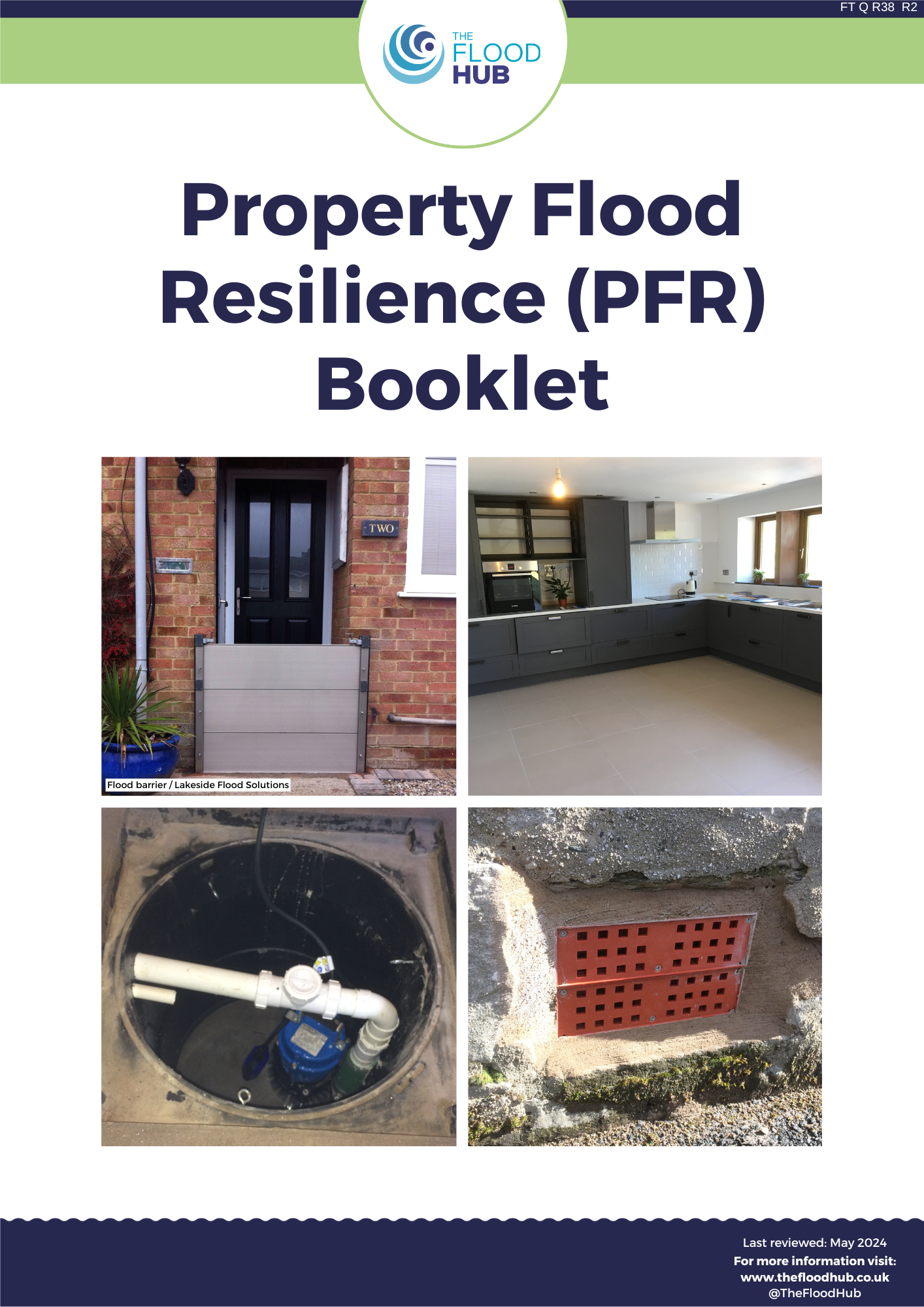
Flood Doors and Windows
Flood doors are available in a wide range of sizes, designs, colours and finishes, including uPVC, composite and hardwood, as well as steel and security doors for commercial premises. Single door and French door designs are currently commonplace on the market, with single ‘stable-door’ type designs also available. Single flood doors with escape hatches located in the top half can also provide a means of passing supplies into a property without opening the door when under flood conditions. When flood doors are closed and the locking system engaged, the in-built sealing system helps to create a watertight seal between the door and its frame to prevent water entry. Flood doors can be custom made to individual design and size requirements.
Appearance wise, flood doors look the same as ordinary doors. In addition to the sealing system between the door and its frame, which cannot be seen when the door is closed, quite often the only difference is the addition of a fourth hinge located on the lower half of the door. If the door is hinged on the inside to open inwards, the hinges cannot be seen from the outside. Some flood doors require the locking points to be engaged for them to work correctly.
Flood windows work in much the same way as flood doors and can be used to replace basement windows or, where floodwaters can reach significant depths and the height of ground floor windows fall within the property’s safe standard of protection.
Considerations:
- Offer round the clock protection.
- Can restrict entry and exit in the event of a flood.
- Suitable option for elderly or disabled residents or those who may be away from the property for extended periods of time.
- Requires annual servicing, and maintenance will be required to maintain warranty and ensure it works as intended during a flood.
Estimated costs:
- Costs start at around £2,000 (Incl. VAT) for a single uPVC Flood Door including installation. French doors, composite, hardwood, and custom-made designs will cost more.
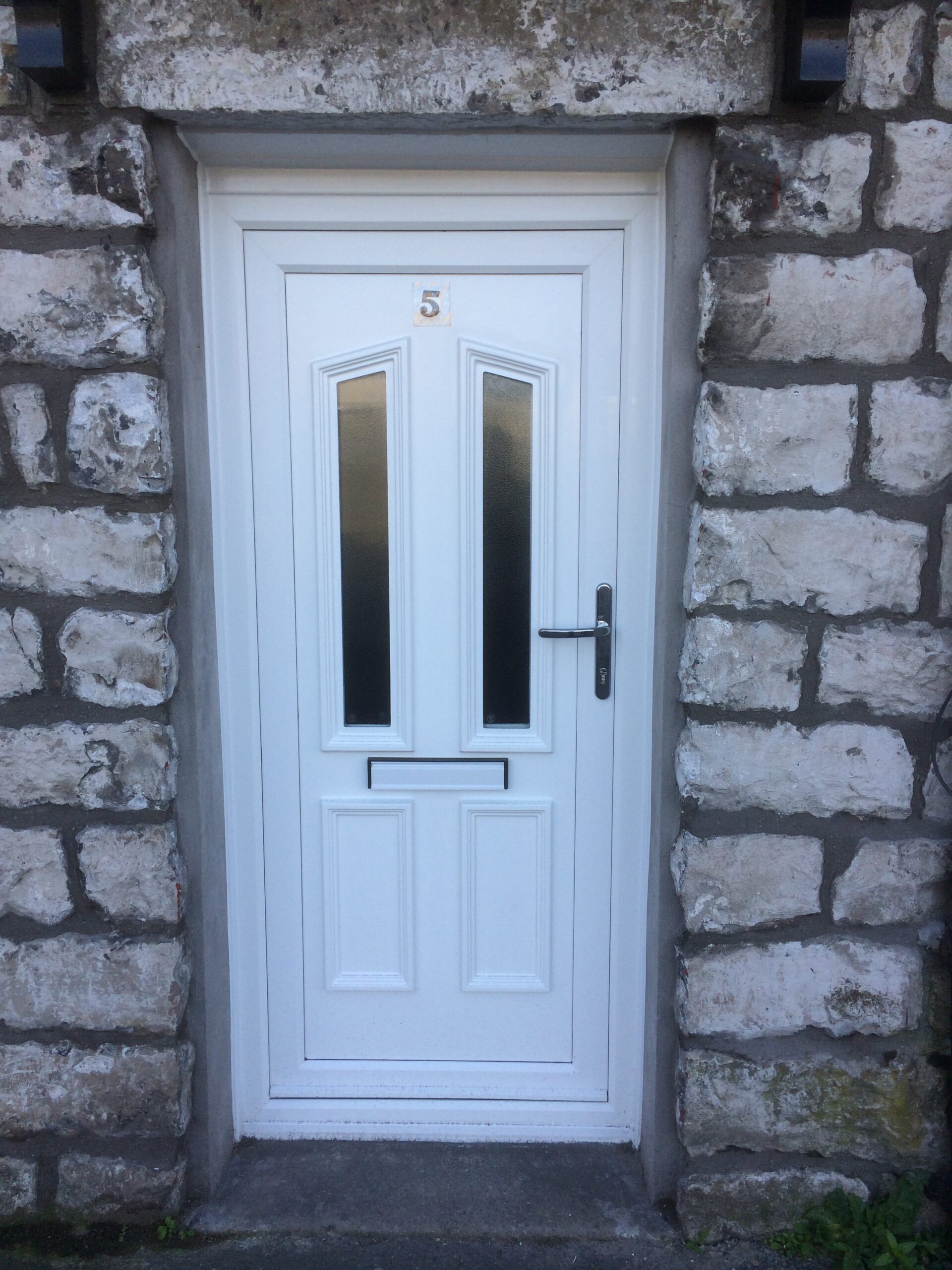
Flood door
Flood Barriers
Flood barrier systems can be fitted to external doorway entrances and windows to protect properties, as well as to garages, garden gateways and driveway entrances. There are considerations when protecting the boundary of your property, such as ensuring an adequate perimeter wall is in place, and whether water will be redirected and cause neighbouring properties to flood. Further guidance and advice should be sought in this regard.
Considerations:
- Maintenance of rubber seals within channels is required and on barrier sections, which may perish over time and need replacing.
- Barriers sections need to be stored correctly to avoid damage to rubber seals.
- Property owners need to be physically able to carry out installation when a flood is expected.
- Barriers can close off access to and from the property on doors that open outwards.
Estimated costs:
- £600 – £900 for a single doorway aluminium barrier, wider barriers at an increased cost.
Click here to download our ‘Understanding Flood Barriers’ resource to learn more about the different types of flood barriers and considerations for installation.
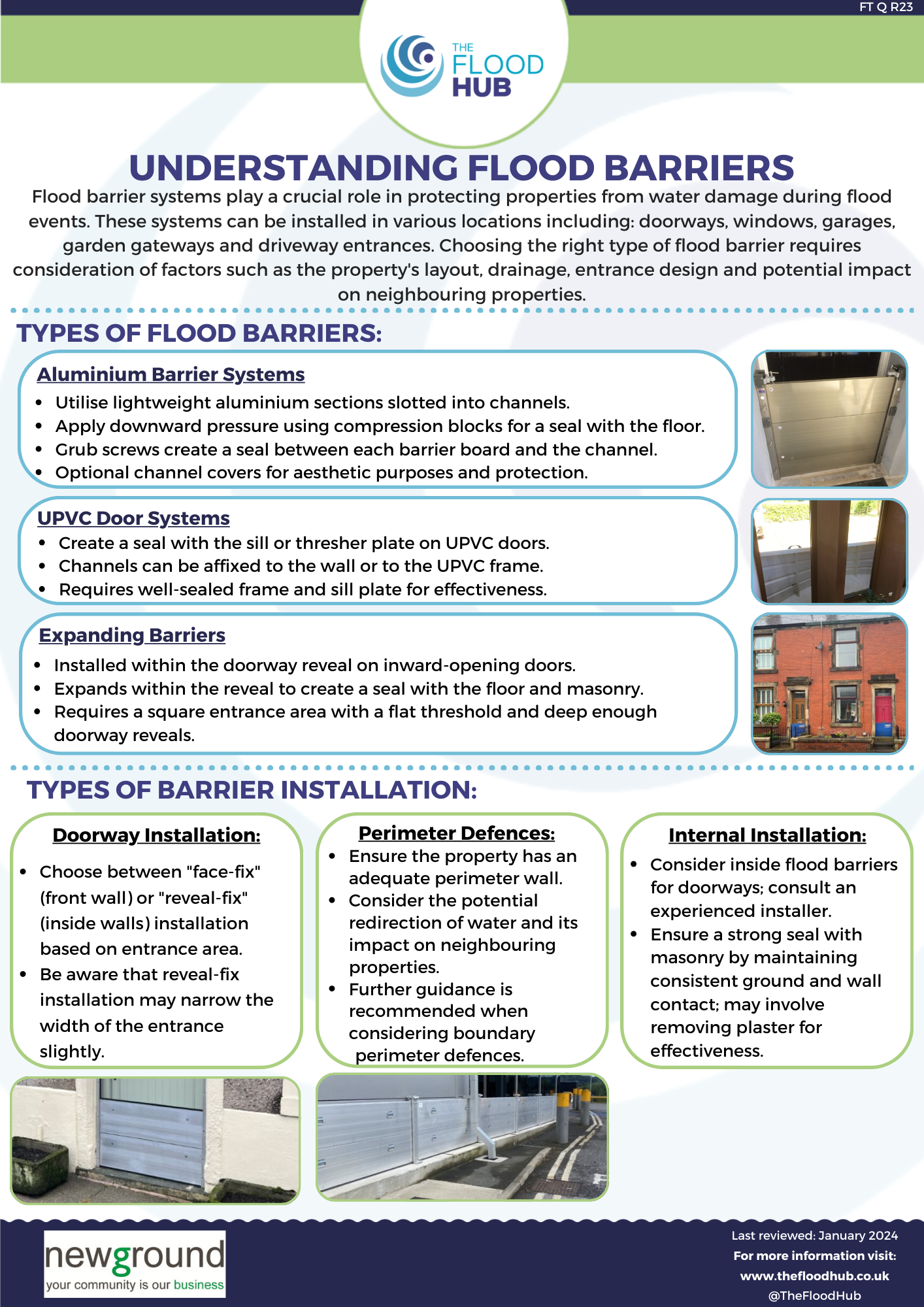
Air Bricks
Automatic Air Bricks
Automatic (self-closing) air bricks are designed to replace traditional air bricks, allowing air flow under normal conditions and self-closing when they come in to contact with floodwater. The mechanism within the air brick contains a cartridge with floating balls which rise with floodwater to create a watertight seal, preventing water from entering the wall cavity and flooding the property. Two units can be stacked to replace a double air brick and they are available in different colours to match brick work and masonry.
The front cover of the unit can be unscrewed and removed to allow access for maintenance. The removal of dirt and insects, cleaning of internal parts and the replacement of rubber seals will be required.
Considerations:
- Offer round the clock protection.
- Require maintenance and cleaning.
Estimated costs:
- £70 (Incl. VAT) for a single unit, additional installation costs will depend on the contractor used.
Air Brick Covers
A lower cost option to automatic air bricks are air brick covers which are designed to be installed over traditional air bricks when flooding is expected. Most covers work by pre-installing a permanent frame around the air brick, and when flood water is expected the cover is clipped in place onto the frame.
Alternatively, self-adhesive patches can be purchased which can be applied or rolled on with an applicator tool to prevent water ingress. Kits are available which include air brick patches and patches designed to help seal around pipes or other small openings in an emergency.
Both types of cover must be removed once floodwater has receded and the adhesive patches are designed for single use only.
Considerations:
- Affordable solution to protect air bricks and small holes.
- Relatively easy to install but must be installed correctly.
- Must be installed when flooding is expected and removed once floodwater has receded.
Estimated costs:
- £20 for a single cover and £20 for a pack of 2x adhesive patches.
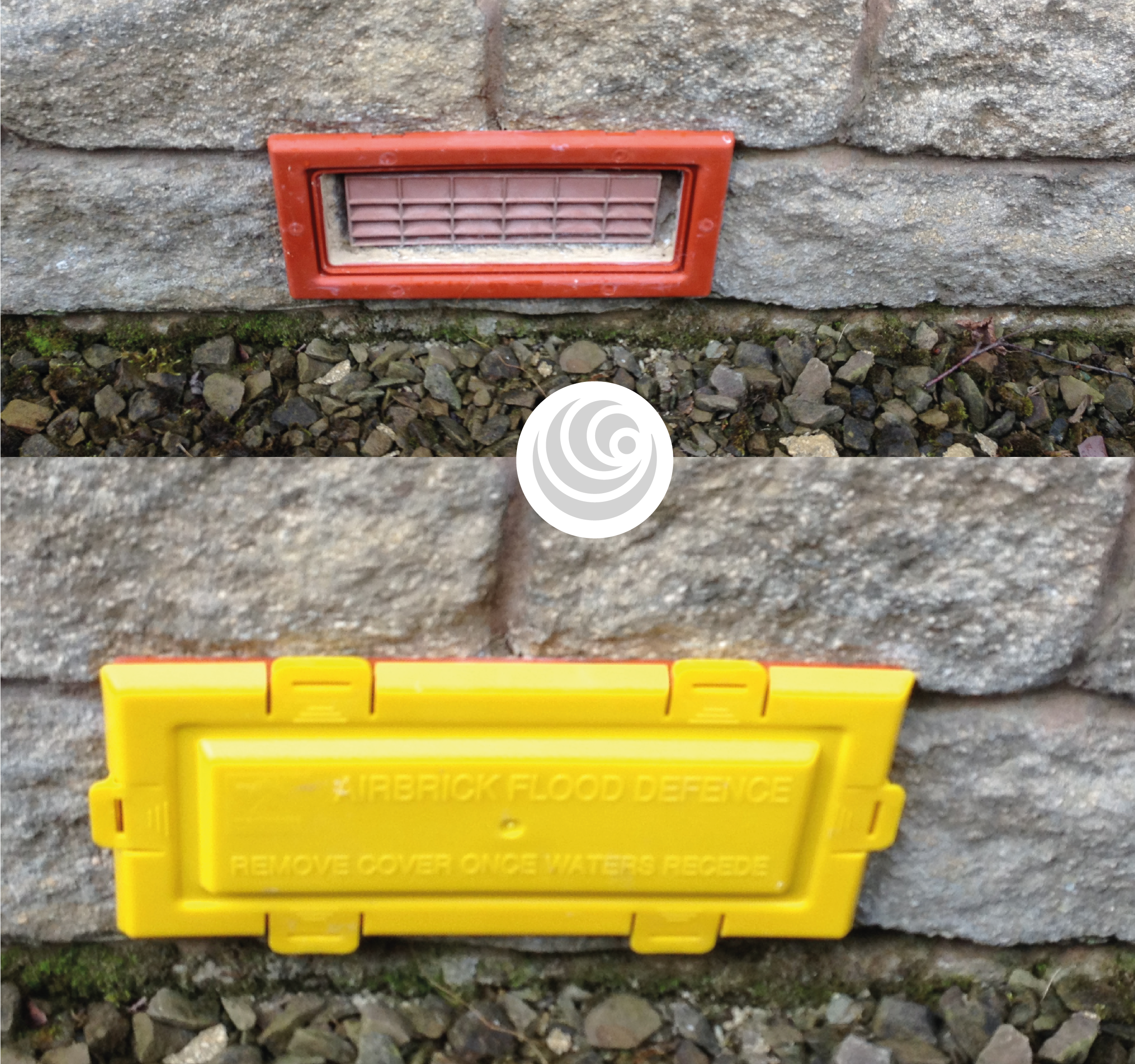
Airbrick cover
One-way Weep Valves
Weep holes provide an outlet for moisture that condenses within the cavity, to run down the inside wall of the cavity to the cavity tray and drain away. They also provide a direct route for floodwater to enter the cavity.
One-way weep hole valves work in a similar way to NRVs and are designed to allow condensation to escape, but close off under flood conditions to prevent floodwater from entering the cavity. Different product designs are available in 8mm or 10mm sizes and in different colour choices to suit brickwork and masonry types.
Considerations:
- Cheap and easy to install.
- Prevents build-up of moisture and condensation within the cavity.
- Prevents bugs and other debris entering and blocking the weep hole.
- Requires maintenance and cleaning.
Estimated costs:
Re-pointing
Gaps, cracks or holes in pointed brick or stonework can allow floodwater into a property. Similarly, any gaps in the wall-floor join of external walls can allow water into the foundations or sub-floor areas of the property. Gaps should be repaired and sealed with a water-resistant mortar.
Considerations:
- A close inspection of all external wall / floor joins and masonry is required.
- Listed buildings may require sampling and testing of existing mortar to create a match for re-pointing.
- On some older properties, a lime mortar specialist may be required.
Estimated costs:
- Will vary dependent on size of the area and contractor used.
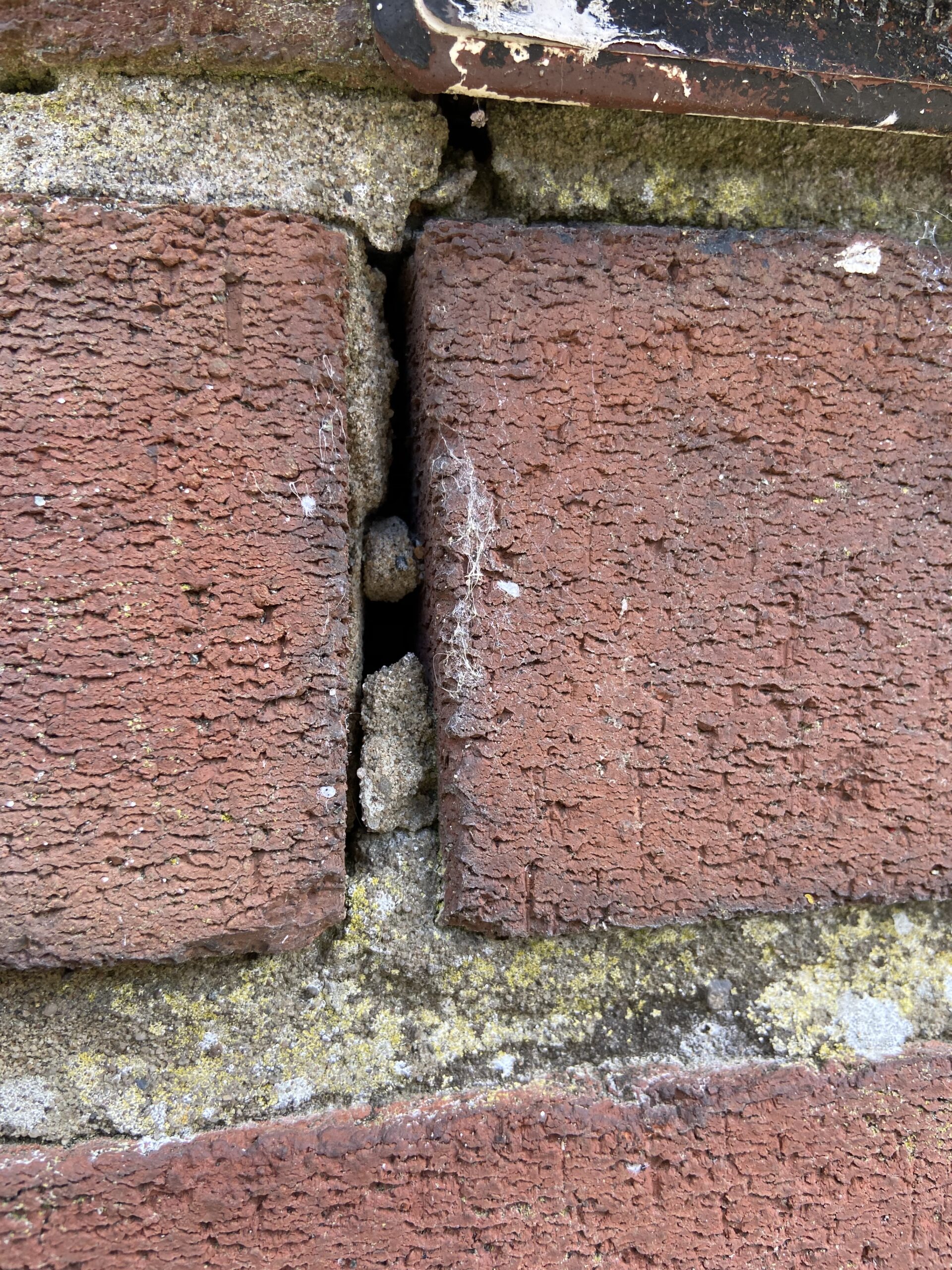
Missing pointing
External Wall Sealants
Different types of brick / stonework and mortar will have varying degrees of porosity and when in contact with floodwater, can absorb water into cracks and fissures. The longer that external walls of a property are in contact with floodwater, the further into the masonry, mortar joints and damp-proof membrane (DPM) the water is likely to penetrate.
The application of suitable waterproofing wall sealant can drastically reduce water ingress and even prevent it altogether.
Considerations:
- Easy to apply with a brush, roller or spray applicator.
- Dries to a natural finish.
- Odourless.
- Allows the transfer of vapour enabling masonry and mortar joints to breathe whilst resisting water.
- Always check that any masonry treatment or product is suitable for your property before applying.
Estimated costs:
- Will vary depending on the size of your property.
Wall Rendering
Water-resistant cementitious wall renders can help to slow down water penetration or prevent ingress altogether. Such works may not be suitable for all buildings or permitted for properties that are listed or located in conservation areas. If in doubt, it is recommended that you consult with your local planning department for further advice.
Rendering from ground level upwards may not be enough in some cases, and the excavation of soil and earth to render section of walls below ground may be needed. Consultation with a reputable flood mitigation specialist or rendering contractor for advice would be recommended.
Considerations:
- Not suitable for all properties and planning permission may be required.
- Seeking professional advice is recommended.
- Can be very effective.
Estimated costs:
Gaps around Pipework and Cable Entry Points
Holes can be found within masonry for wastewater outlet pipes, utility pipes and cables, aerial and satellite cables, telephone cables and more, and provide access routes for floodwater to enter a property if they are not properly sealed. Re-pointing mortar and silicone sealants can be used to close off these entry points. Adhesive patches can also be purchased to wrap around pipework in an emergency.
Considerations:
- Silicone sealants will perish over time and need renewing.
- A thorough inspection around the property is required to ensure all entry points are identified.
Estimated costs:

Silicone sealant around cable entry point
Utility Meter Housings and Covers
Standard meter housings and door seals are not designed to be watertight, with gaps in the frame and holes for supply feeds and cables to enter through the wall of the property. External gas, electric and water meters that are low enough to come into contact with floodwater will need water entry points sealed.
In most cases, the meters themselves belong to the utility service provider, but the housings in which they are located belong to the property owner.
Flood-proof meter box housing covers are available and can be used to protect the existing meter housing. To replace the housing itself, it is recommended that you contact your service provider to discuss this and ensure a competent and qualified trades person undertakes the work.
Considerations:
- Provides 24/7 round the clock protection.
- A made-to-measure solution may be required.
- Regular inspection and replacement of sealant around the frame and door seals is required.
Estimated costs:
£500 +VAT including installation.
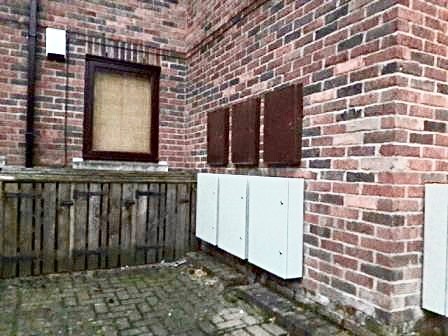
Meter box covers
Vent Covers
Vent covers protect air vents and vents for some appliances such as tumble dryers. They comprise of a surrounding frame which remains permanently in place and the cover is clipped in place when floodwater is expected. The rubber seals and securing clips help to create a watertight seal.
Specialist advice and guidance must be sought when looking to protect a vent or flue for a gas or fuel burning appliance.
Considerations:
- Appliances must not be used when the cover is in place.
- Not suitable for all appliances.
- Maintenance of seals is required.
Estimated costs:
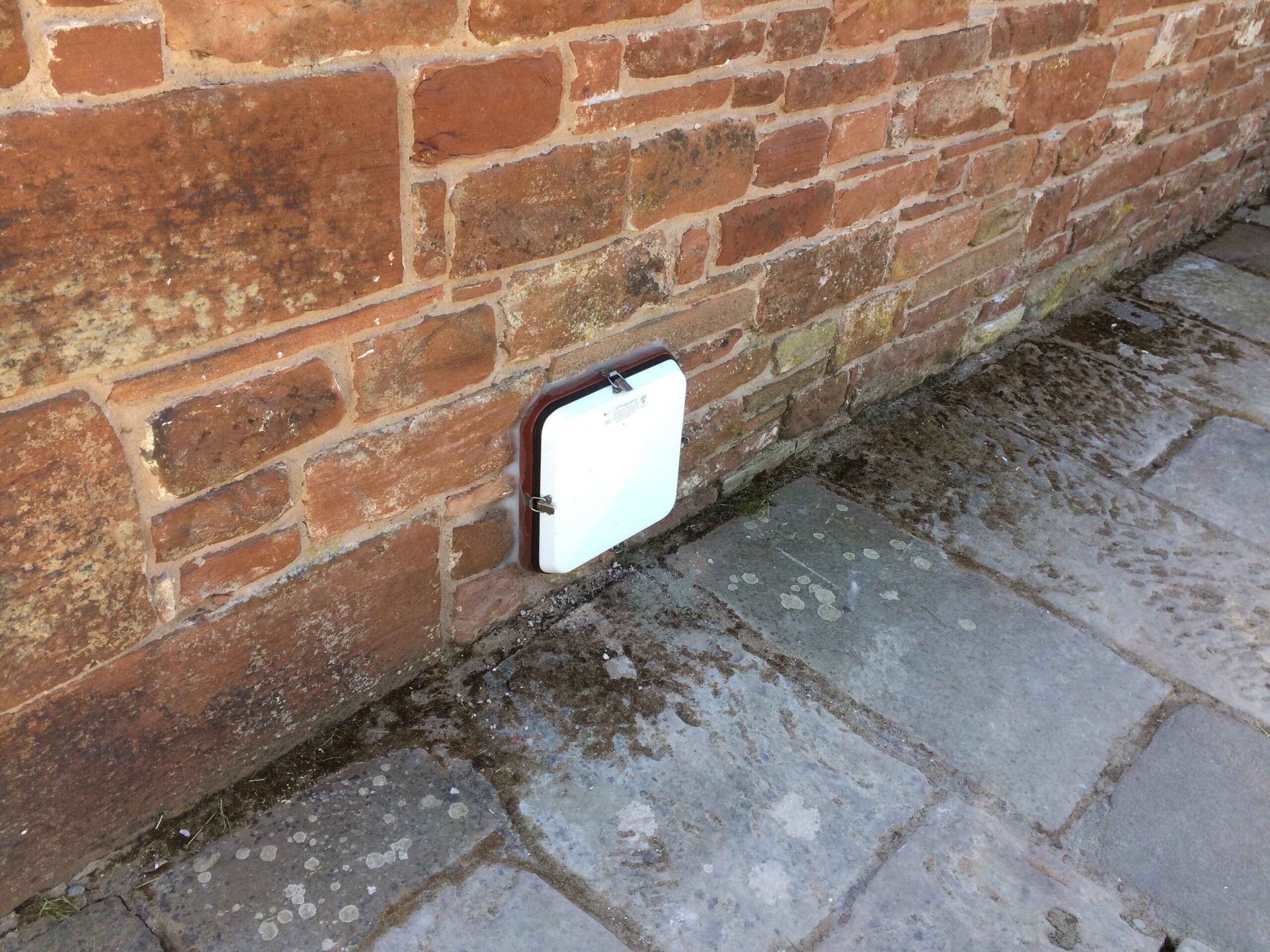
Vent cover
Non-return Valves
In bungalows or properties with ground floor toilets, foul sewer water can back up (surcharge) from the main sewer system via the waste pipe and emerge out of the toilet, flooding the home internally. Water can also back up through other bathroom and kitchen appliances and cause internal flooding. This may include shower trays, baths and sinks, dish washers and washing machines.
Waste pipes can be protected from backflow with non-return valves (NRVs) which can be installed in-line to the pipe itself where access is available. Where access is not available, they can be installed in-line between the toilet and the inspection chamber outside which will require excavation works.
Alternatively, one-way ‘push-fit’ flap gates can be installed within the inspection chamber itself to prevent foul water backflow within the chamber progressing further backwards up the waste pipe and into the bathroom.
Considerations:
- Permanently protect against the backflow of foul water, foul smells and rodents 24/7.
- Large NRVs can require some external excavation for installation.
- Flap gates installed within the chamber can be a quick and more affordable solution.
- With NRVs installed, toilets should not be flushed, and other appliances should not be used during a flood.
- Require periodic maintenance, cleaning and replacement of rubber seals etc.
Estimated costs:
Small wastewater NRVs from £20 plus installation, flap gates from £60, and in-line NRVs from £150 plus installation.
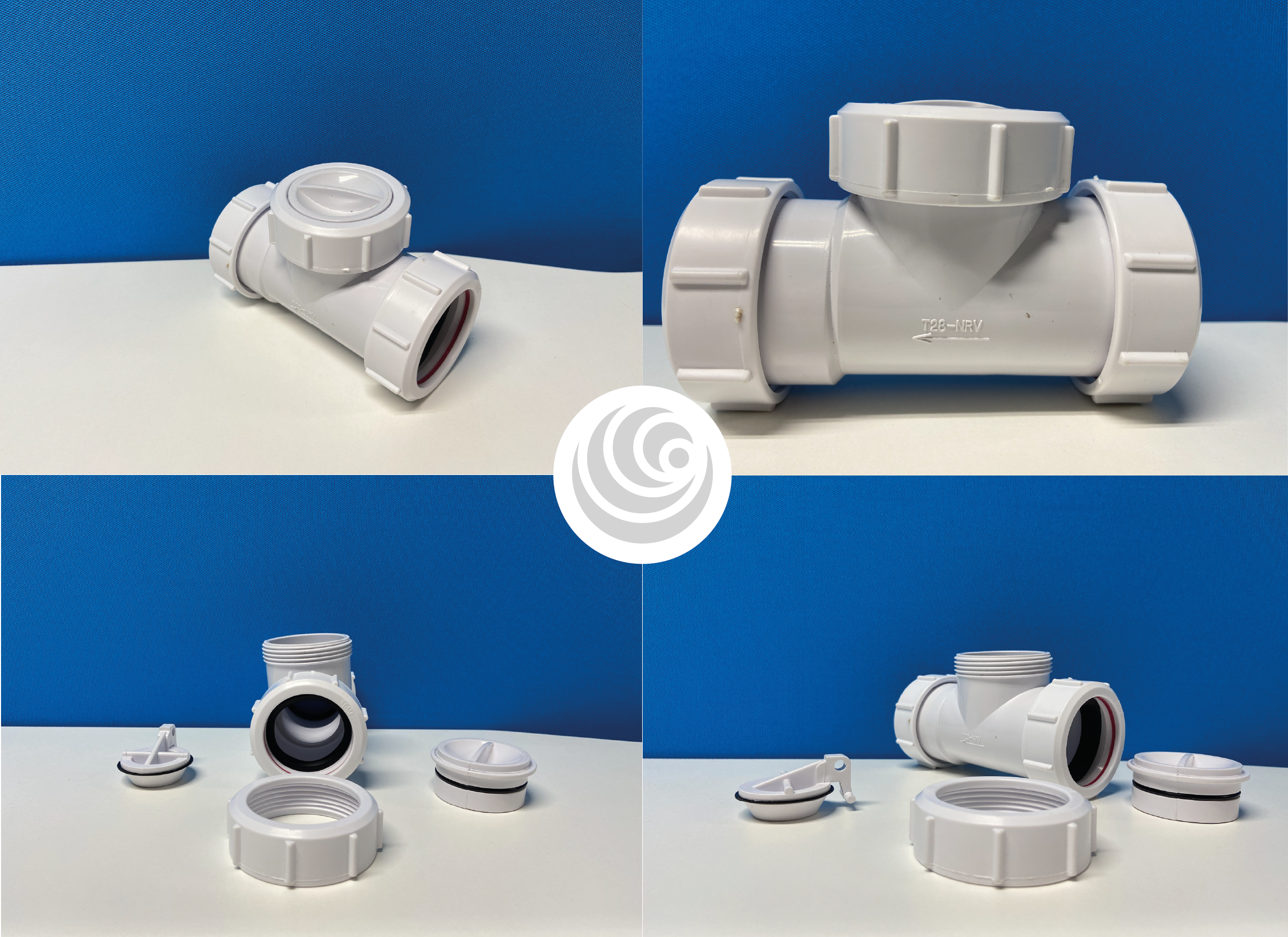
Non-return Valve
Inflatable Toilet Pan Seals and Bungs
To protect properties against the backflow of sewage and floodwater through the toilet where non-return valves cannot be easily installed, inflatable toilet pan seals and bungs offer an alternative solution. Both products can be inflated with a standard bicycle tyre type pump.
Pan seals are designed to work with oval shaped bowls and are placed into the bowl and inflated to create a watertight seal beneath the rim of the bowl. Bungs are designed to be pushed down in the U-bend of the toilet and inflated when in place.
Considerations:
- Requires manual installation when flooding is expected.
- Quick and easy solution with minimal installation.
- Pan seals are not designed to work with square toilet bowls.
- Regular testing and inspection for puncture marks is recommended.
Estimated costs:
£40 – £50
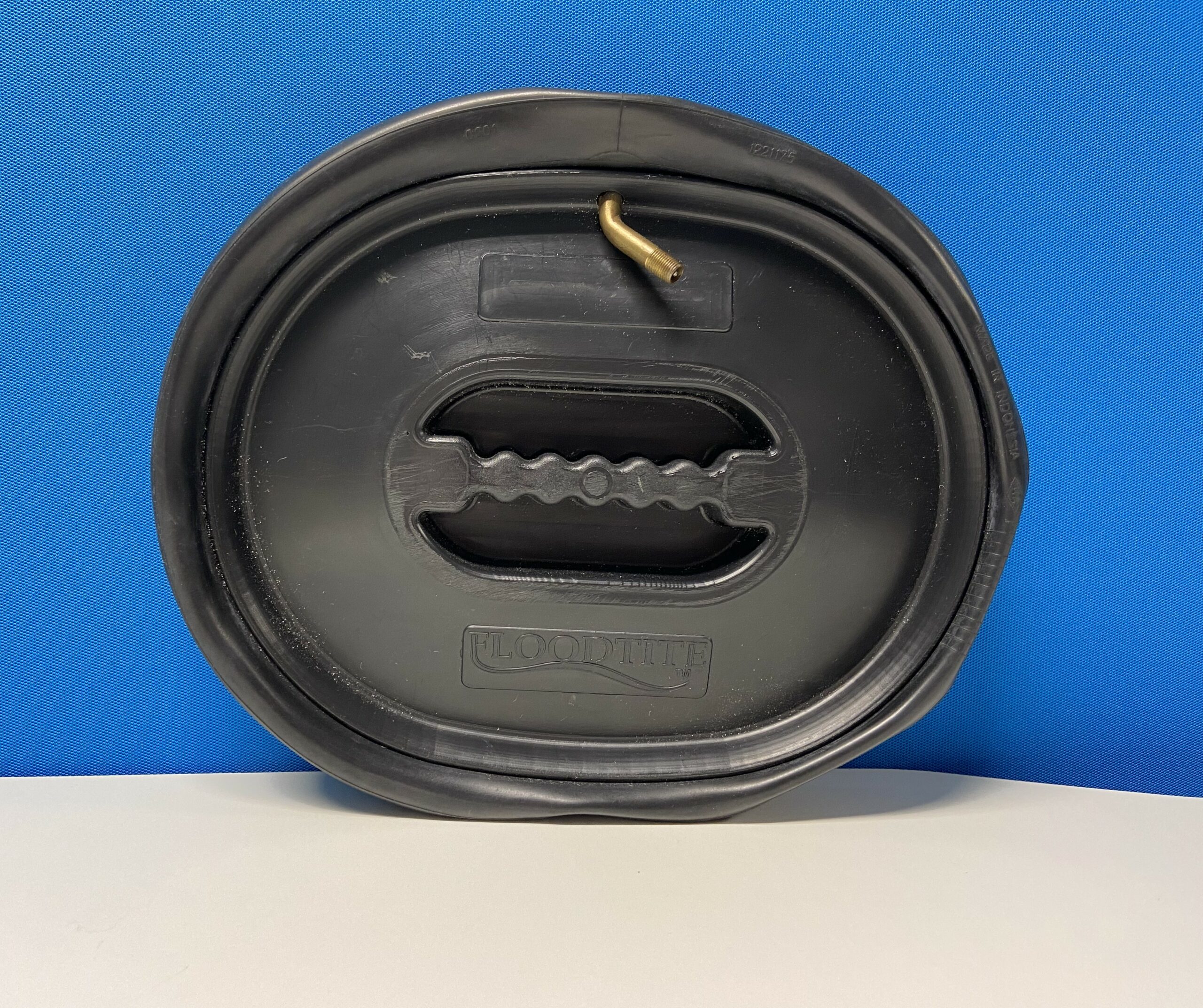
Inflatable toilet pan seal
Raised Utility Meters and Electrics
Water, electricity, and gas meters and electrical sockets that sit within the level of floodwater on ground floors are subject to damage when flooding occurs. The meters, wiring and sockets can be raised or moved to a higher location above the anticipated level of floodwater to prevent future damage to electrical services. Electrics can also be wired from the ceiling downwards instead of coming up from under the floor.
Utility meters often remain the property of the service provider, so it is recommended that you contact them first to discuss moving the meter and ensure a competent and qualified tradesperson undertakes the work.
Boiler units and ancillary devices should be installed above the predicted flood level and preferably on the first floor of a building. Electrical equipment such as TVs or PCs should be installed above the flood level by wall mounting or placing on raised cabinets.
Considerations:
- Moving utility meters and re-wiring the whole ground floor can be complex and expensive.
Estimated costs:
- Dependant on the works needed.
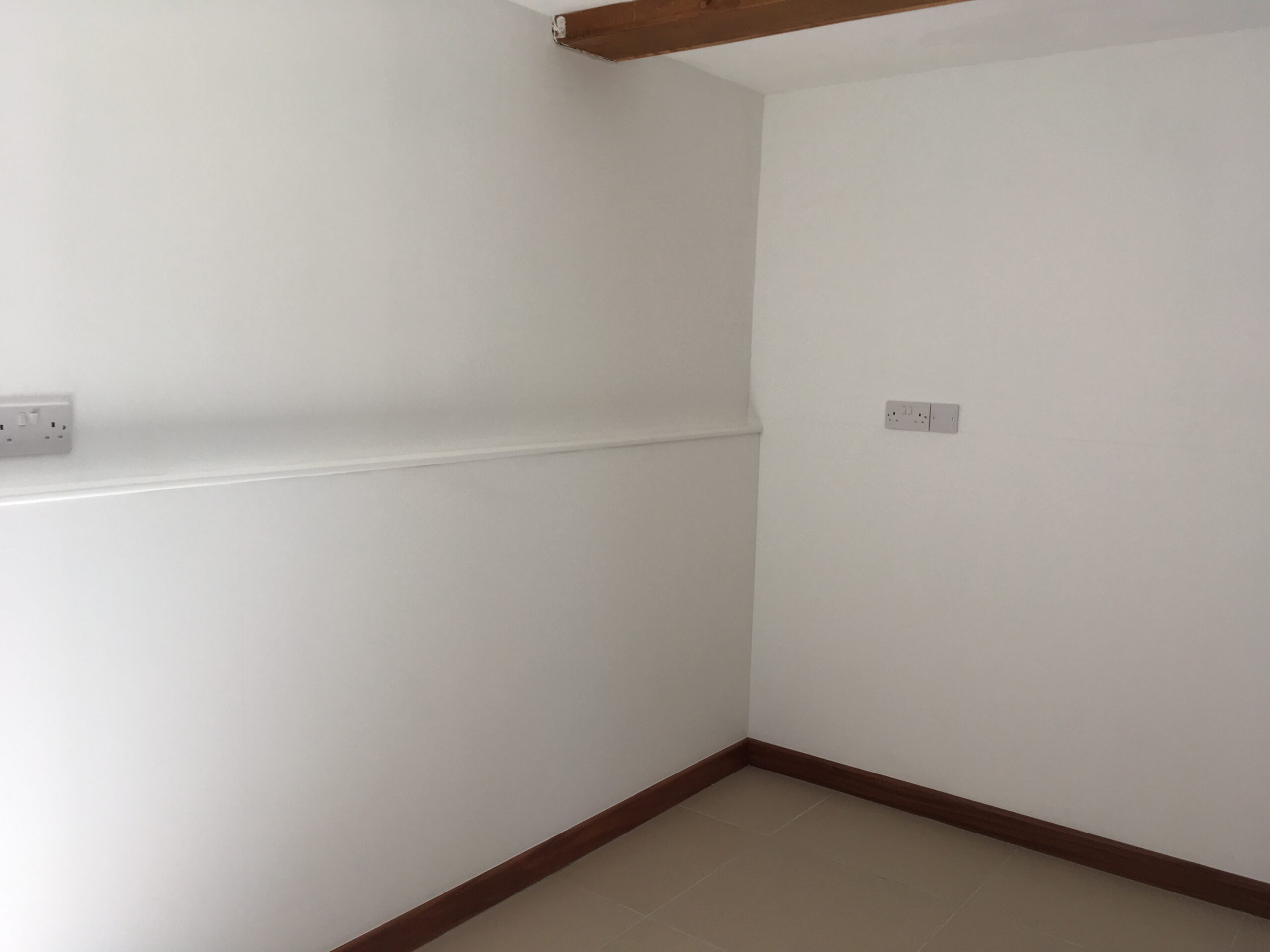
Raised electrical sockets
Internal Doors and Skirting Boards
Replacing doors with hardwood or other water-resistant alternatives and replacing skirting boards with a uPVC alternative reduces flood damage as these materials will avoid absorbing water or being warped. Following flooding they can easily be cleaned and won’t need to be replaced.
Quick release hinges can also be fitted to internal doors allowing them to be lifted up and easily moved to a higher location when flooding occurs.
Considerations:
- Replacing hinges is a cheaper option to replacing the doors themselves.
- Moving doors would need to be done before floodwater enters.
Estimated costs:
- Quick release hinges £10-20. Hardwood doors £50-100. uPVC skirting boards £10-20 per board.
Water Resilient Walls
Waterproof wall boards such as dragon board, aqua board and magnesium oxide board are more resilient to water than traditional gypsum-based plaster boards. If using traditional gypsum plaster boards, installing them horizontally can reduce the amount of remedial work needed after flooding. Materials such as lime plaster or cement render with waterproof additive reduces the likelihood that walls will be damaged by floodwater.
Walls can be painted with water resistant paints or tiled. Ceramic tiles and water-resistant grout provide a resistant surface and shouldn’t need replacing following a flood. Tiles should be laid over sand or cement render, not gypsum-based plaster. Closed cell insulation is more resistant to water than traditional insulation materials.
Considerations:
- Using water-resistant paints is an easier option to tiling.
- Extra consideration for the building fabric of older properties.
Estimated costs:
- Waterproof boards £20 per square metre. Water-resistant paints £30-40.
Water Resilient Floors
Solid concrete, concrete based stone, and ceramic tiled flooring are resilient to floodwater and easy to clean. Wood effect tiles are also available. All tiles should be laid on cement-based adhesive using water resistant grout.
Replacing floorboards and joists with water resistant, treated timber will reduce water absorption and allow the floor to dry out quicker, reducing the chances of rot and distortion. Installing a chemical damp-proof course below suspended timber floor minimises sub-floor condensation, preventing rotten joists and floorboards.
Considerations:
- Easily removable carpets and rugs can be used to keep comfort.
- Replacing flooring can be expensive.
Estimated costs:
- Dependant on material used and size of flooring.
Water Resilient Kitchens
Water resistant materials, such as stainless steel, bio composite, hardwood, or waterproof construction board can be used for kitchen units. These can easily be cleaned following flooding, and this avoids the need to replace them.
Appliances such as fridges and washing machines can be raised on plinths and electrics raised above the likely flood level. Baskets can be used to store kitchen utensils so they can be moved or taken upstairs when flooding is expected.
Considerations:
- Helps for a quick recovery following flooding.
- Can look the same as “normal” kitchen units.
- May be expensive to replace all kitchen units.
Estimated costs:
- Dependant on size of kitchen and materials desired.

Kitchen designed with flood resilient materials
Basement Tanking
For basements experiencing damp and small puddles of water, applying a cementitious wet tanking slurry to the floor and walls can help to seal small gaps and cracks and create a waterproof layer.
Basements which are regularly prone to more significant flooding from groundwater that need to be made completely waterproof can be protected by a cavity drain membrane system. This is complex and involves the installation of a sump chamber with pump system to the basement floor, drainage channels, and a cavity drain membrane for the walls and floor.
Once in place, wall and floor insulation can be installed, followed by a range of finished wall surface options.
Considerations:
- Professional advice and installation are required.
- Tanking systems can fail if not installed correctly.
- Cavity drain membrane systems are designed to be completely waterproof with installations often guaranteed for 20+ years.
- Cavity drain membrane systems are expensive and can be susceptible to damage from future alterations to the room.
Estimated costs:
- Expensive and dependant on size of the basement.
Sump and Pump Systems
Sump and pumps systems remove water that has accumulated in a collection sump. They are usually installed in basements and sub-floor voids and self-activate via a float switch when water enters the sump pit. The water is then pumped through a discharge pipe to the outside of the building, with a non-return valve on the discharge pipe to prevent the back flow of any floodwater from outside of the property.
Pump systems reduce the amount of floodwater within the property and the length of time it remains after floodwater has receded, which reduces damage and helps to speed up the cleaning and drying process. The size of the system will need to be large enough to cope with the anticipated load and it is recommended that a suitable system is installed by a competent professional. Rather than power the pump via a 3-pin plug plugged into an electrical outlet, the pump itself should be hard-wired on its own circuit to prevent loss of power to the pump as a result of a circuit tripping out on the consumer unit during a flood.
While sump and pump systems are designed to go long periods of time with little use, maintenance as per the manufactures guidance is required. If installed within a sub-floor void beneath a suspended timber floor, the installation of a trap door for access is also recommended. You can check the pump is working by periodically pouring some buckets of water into the sump which should activate the pump to pump out the water.
Considerations:
- Specialist advice and professional installation is recommended.
- Servicing and maintenance required.
- Electricity supply can be cut off during a flood so a battery backup unit or a backup generator may be needed for electric pumps.
- Great for dealing with groundwater flooding.
Estimated costs:

Sump and pump system
Puddle Sucker Pumps
Submersible / puddle-sucker pumps are stand-alone pump units which can be deployed to help remove minor water ingress. This could be a flood barrier leak, minor seepage into the property as a result of groundwater, or party wall seepage as a result of a neighbouring property flooding. Discharge hoses need to be connected and placed through a window, letter box, or over a flood barrier etc.
Considerations:
- Good to have as a failsafe or back up in the event of water entry.
- Can be used as part of a package of flood resistance or recoverability measures to help remove minor water seepage and leaks.
- Need to be manually installed and operated, and only powered when in contact with floodwater.
Est. Costs:
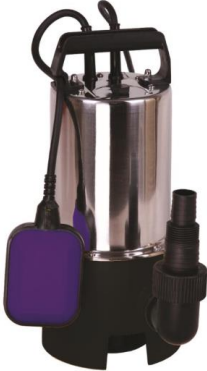
Puddle sucker pump
Click here to download our resource all about sump and pump systems and how they are used.
